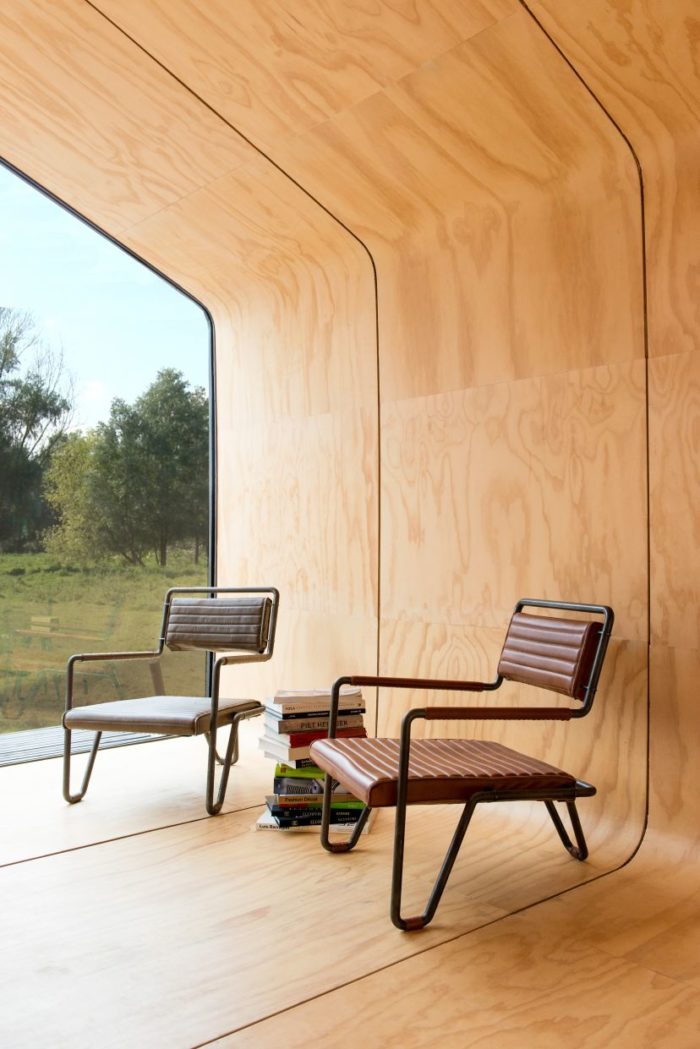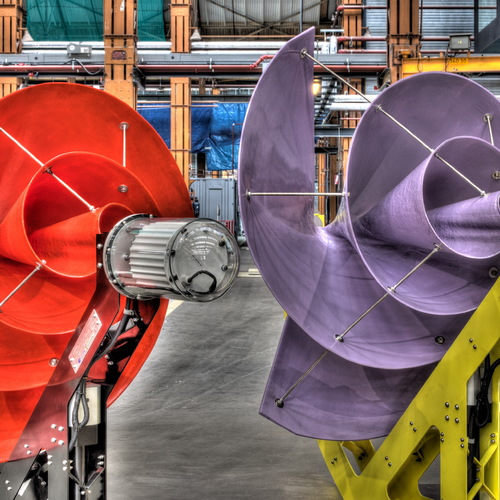Image Credit: All photos: Yvonne Witte
Image Credit: All photos: Yvonne Witte Each segment is made by wrapping 24 layers of cardboard around a metal form. Interior surfaces are lined with plywood; exterior surfaces are protected by a vapor permeable but waterproof layer and wood cladding. Each segment requires 320 meters (1,181 feet) of cardboard. A Wikkelhouse is set on an above-ground chassis, not a conventional foundation. The developer says a Wikkelhouse has a variety of potential uses, and because of its light weight can be moved to a new location should the need arise.
Dutch entrepreneurs have discovered you can do more with corrugated cardboard than make boxes.
A Dutch firm called Fiction Factory has developed a modular building system based on segments of glued-up cardboard. Developers say the Wikkelhouse has a number of environmental advantages over conventional structures.
The Wikkelhouse is one of a number of structures made with unconventional materials and building techniques that have popped up in the last several years. It may be one of the most unusual yet. To build one, fabricators unwind a spool of corrugated cardboard and layer it over a metal form (see image #2 below) to create walls 24 plies thick. The cardboard is protected from the weather by a waterproof but breathable “foil” and wood cladding, and lined on the inside with plywood.
A Wikkelhouse, which gets its name from the Dutch verb for “wrap,” is built from any number of these modular sections. Each is 1.2 meters (3.9 feet) deep, 4.6 meters (15 feet) wide and 3.5 meters (11.4 feet) high, and they can be linked together to make a building of just about any length. Each section has a floor area of about 58 square feet; a standard building consists of three segments totaling about 175 square feet and sells for €25,000 (about $26,700 at current exchange rates). This includes a service section with bathroom and kitchen fixtures.
Amsterdam-based Fiction Factory markets the Wikkelhouse as a vacation home, a guest house, or office space. “Wikkelhouse can be whatever you want it to be,” the company’s website says.
Tomato crates today, houses tomorrow
The idea for making a house from cardboard started with a paper industry veteran named René Snel, explained Rick Buchter, who manages the Wikkelhouse project for the Fiction Factory.
Snel originally devised machinery to make tomato crates by wrapping layers of cardboard around a form. He was impressed with the potential of the process, Buchter said, and built the original Wikkelhouse machine to make segments for houses. But Snel ran into problems. There was no market for cardboard houses, and Snel didn’t know how to make the segments waterproof, or how to connect the pieces into a sturdy whole. A few years ago, he discontinued the project.
The Fiction Factory stumbled onto the mothballed machine in an Amsterdam warehouse in the course of working with Snel on another project. Once he explained what the device was for, Fiction Factory was intrigued enough with the possibilities that it took over the project and began working out the bugs.
It takes two 160-meter rolls of cardboard to make each segment, Buchter explained. After winding 12 layers of cardboard around the form, fabricators insert a “separation layer” that includes wood ribs and space for steel rods that ultimately connect one segment to another. Then a second roll of cardboard is added, making a total of 1,181 feet of cardboard.
The layers are glued together with wood glue and allowed to dry for several hours before the segment is removed from the form. A steam-bent plywood skin 9 mm (about 3/8 inch) thick is added to the inside to protect the cardboard from wear and moisture. The exterior waterproofing membrane, which Buchter likened to Gore-Tex, is commercially available in Europe.
The company currently produces about a dozen houses per year, and sells everything it makes. It intentionally limits distribution while it gears up to increase production in the future. The buildings are being sold in the Netherlands, Belgium, Luxembourg, France, Germany, the UK, and Denmark, and the company does not expect to expand that market until 2019.
“We get a lot of interest from all around the world,” Buchter said. “We want to keep the customers we have now. We want to sort out the clients who really want a house, so we’re trying to lower the demand a bit.”
Durable and portable
The structure can be assembled on an above ground support called a chassis and doesn’t need a conventional foundation. A three-segment building of about 175 square feet could be assembled in one day, the company says.
The Fiction Factory promises the buildings have “exceptional constructive strength,” “optimal insulation qualities,” and an expected life span of at least 50 years. The materials are recyclable. Segment walls are 12 cm (4.72 inches) thick and have a metric R-value of 3.5 (the equivalent of R-20 in the U.S.), according to Buchter.
With a weight of 500 kilograms per segment (about 1,100 lb.), a three-segment house would weigh less than a Ford 150 pickup truck, suggesting even a fully assembled building wouldn’t be too difficult to move.
Fiction Factory describes itself as a “company of creative makers” that has been making interiors, fair stands and furniture for a worldwide market since 1989.
Cardboard may seem like an odd choice for a house, but maybe it’s not so weird after all: In 2015, Lexus introduced a drivable car made from the same material.
Weekly Newsletter
Get building science and energy efficiency advice, plus special offers, in your inbox.













2 Comments
R20 is not terrible but one
R20 is not terrible but one side all glass, plus the plywood has no fire resistance.
I don't think any building codes will approve this house for habitation.
plywood as thermal barrier
A good discussion
https://www.greenbuildingadvisor.com/blogs/dept/musings/thermal-barriers-and-ignition-barriers-spray-foam
Log in or create an account to post a comment.
Sign up Log in